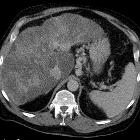Hypertrophie des Lobus caudatus

Massive
Steatosis hepatis mit erheblicher Hypertrophie des Lobus caudatus (Segment I) als Zirrhosezeichen. Bei Alkoholanamnese ist dies als Ursache anzunehmen.


Hypertrophy
of the caudate lobe • Caudate-right lobe ratio (diagram) - Ganzer Fall bei Radiopaedia
Hypertrophy of the caudate lobe is seen in a number of conditions, including:
- cirrhosis: most common
- Budd-Chiari syndrome
- primary sclerosing cholangitis (end stage)
- congenital hepatic fibrosis
- cavernous transformation of the portal vein
Radiographic features
The caudate-right lobe ratio may be useful in quantifying caudate hypertrophy. A ratio of greater than 0.65 indicates a high likelihood of cirrhosis.
Siehe auch:

 Assoziationen und Differentialdiagnosen zu Hypertrophie des Lobus caudatus:
Assoziationen und Differentialdiagnosen zu Hypertrophie des Lobus caudatus:



